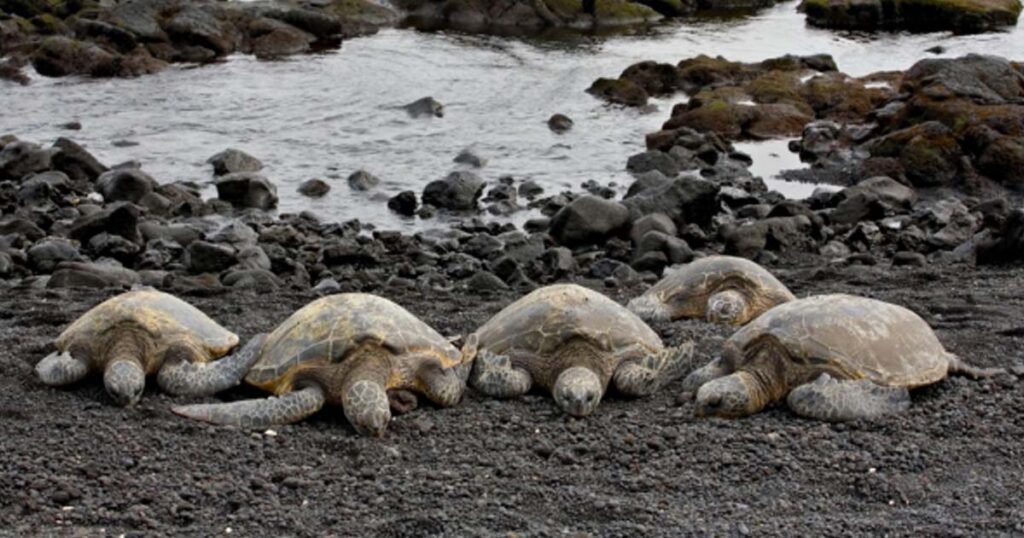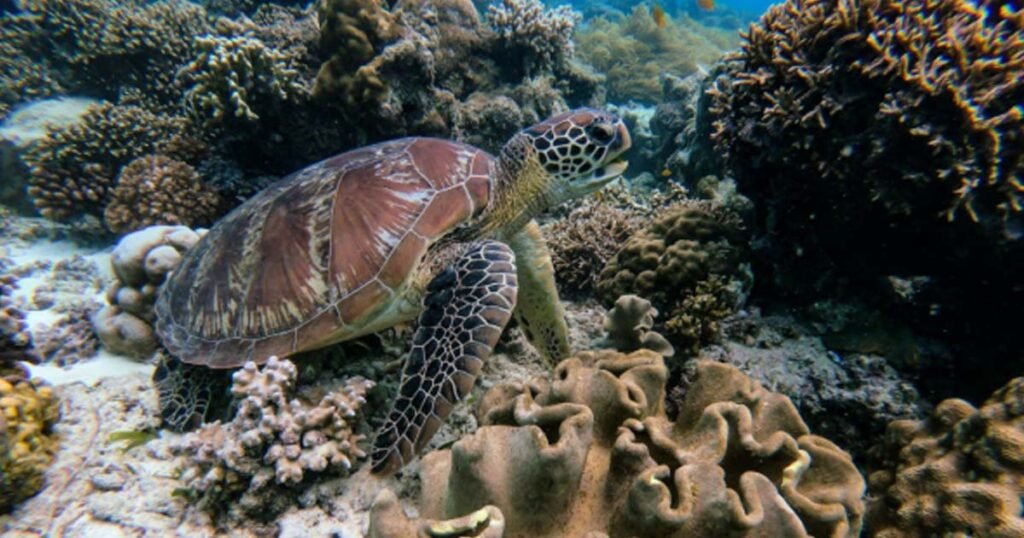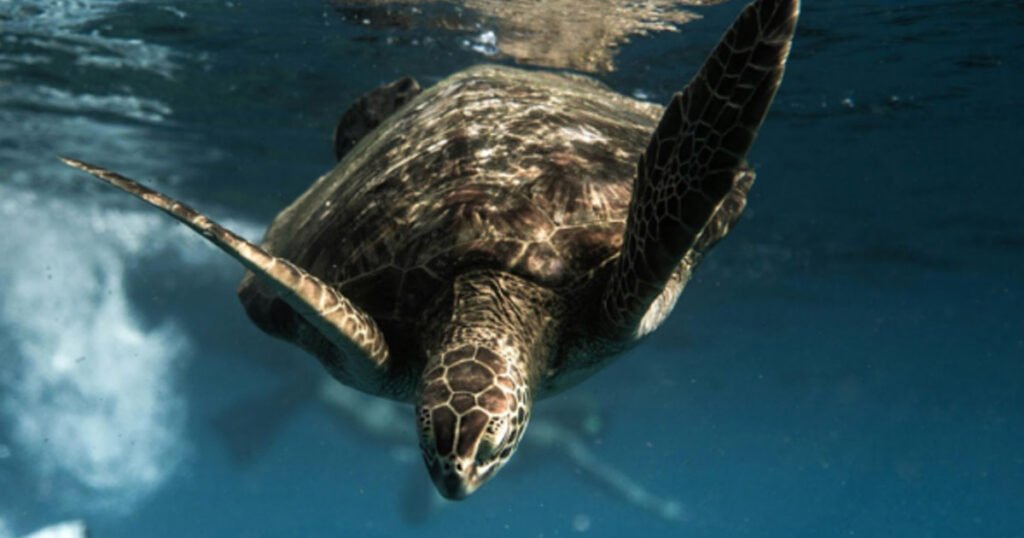When we think about dangers to sea turtles, we often exclusively consider human-caused pressures. However, sea turtles face numerous threats from natural predators throughout their lives. What are sea turtles predators? Predation pressure on sea turtles begins before they hatch, when nests may be plundered by animals such as raccoons or foxes, several crab species, or a variety of bacteria, insects, mites, and other organisms.
Table of Contents
What Are Sea Turtles Predators?

So, What are sea turtles predators? Sea turtles are endangered even before they are born. When a mother comes to the beach to lay her dozens or hundreds of eggs, terrestrial predators wait for the right opportunity to dig in the sand, pick up the eggs, and consume them. If the kids survive long enough to leave the nest, they are preyed upon by a variety of bird, reptile, and mammal species as they travel through the sand from nest to sea.
Finally, even if they make it to the sea, their survival is not guaranteed because the marine fauna is diverse and practically any species could pose a lethal threat to them while still young. Unfortunately, because of these hazards, only approximately 10% of the children survive to adulthood.
As they grow and gain size, their physical traits become more resistant and strong, making it more difficult for predators to attack them, while huge sharks, some animals, and crocodiles pose a threat at any point in their lives.
Do Sea Turtles Have Natural Predators?

When sea turtle hatchlings make the perilous trek from the sandy nest to the water, they confront numerous threats. Birds such as seagulls and crabs watch for these small turtles as they scurry across the sand. Only a few fortunate individuals make it to the safety of the water.
Young sea turtles remain vulnerable once they have entered the water. Big fish, such as sharks and some species of larger fish, view these juvenile turtles as good food. They must be extremely fast and intelligent to escape becoming someone else’s food!
Sea turtles get stronger and more adept at self-defense as they age and gain size. However, they must remain vigilant against predators. Sharks are likely their greatest threat, particularly to adult sea turtles. Sharks possess powerful jaws and sharp teeth, making them formidable opponents.
Aside from sharks, adult sea turtles may have to watch out for some species of killer whales and larger predatory fish. Even as they get larger, sea turtles must remain alert and utilize their wits to avoid these predators.
However, not all is bleak. Sea turtles use creative tricks on their flippers to help them survive. Their shells, for example, offer great protection against predators. Furthermore, they are fast swimmers, and their inherent camouflage allows them to blend in with their surroundings, making it difficult for predators to detect them.
So, while sea turtles have natural predators, they also have some interesting adaptations that help them stay safe in the vast, blue ocean!
What Are Green Sea Turtles Predators?
Mature Green Turtles should be careful of larger shark species as their only natural predators. Juveniles and hatchlings confront numerous predators, including crabs, birds, and mammals.
Fire ants, crabs, lizards, birds, dogs, raccoons, wild pigs, coyotes, dolphins, sharks, and a variety of carnivorous fish such as snapper, grouper, and barracuda are among the most common sea turtle predators. Fire ants feed on eggs and weak hatchlings.
The most serious risks to green turtles include bycatch in commercial and recreational fishing gear, vessel strikes, loss of nesting habitat due to coastal development, and climate change.
Predators of Adult Sea Turtles
Adult sea turtles might be big and strong, but they still have to watch out for some fierce predators underwater. One of their biggest threats is sharks—these big fish have powerful jaws and sharp teeth, making them a real danger for sea turtles.
Apart from sharks, adult sea turtles also have to be wary of certain types of killer whales and big predatory fish. These animals see sea turtles as a tasty meal and will chase them down if given the chance.
But it’s not just underwater enemies that adult sea turtles need to worry about. Sometimes, they can also face dangers from people. Pollution, fishing nets, and boats can all harm sea turtles, even though they’re not natural hunters.
What Are Leatherback Sea Turtle Predators?
Despite their great size and strong skin, leatherback sea turtles still face predators in the ocean. Adult leatherback sea turtles are less likely to be preyed upon due to their size and power, but their eggs and hatchlings are far more vulnerable.
Raccoons, foxes, and feral pigs are among the most common predators of leatherback sea turtle eggs. These animals may readily dig up turtle nests and consume the eggs inside, threatening the survival of leatherback sea turtle populations.
When hatchlings emerge from their eggs and make their way to the water, they encounter a slew of predators. Birds like seagulls and crabs are opportunistic feeders, preying on hatchlings as they scamper across the beach toward the ocean. Furthermore, species like snappers and groupers may hunt hatchlings as they swim in shallow coastal waters.
However, as leatherback sea turtles turn into adults, their size and excellent swimming ability make them less vulnerable to natural predators. While they may still face risks from huge sharks and killer whales, adult leatherbacks are better able to defend themselves and are less vulnerable to predation than their younger counterparts.
Overall, while leatherback sea turtles are preyed upon at various times of their lives, their big size, protective shells, and swimming adaptations allow them to survive and thrive in the water.
Predators of Sea Turtle Eggs and Hatchlings

Sea turtle eggs and hatchlings have to be super careful because they have some sneaky predators hiding around. When mama sea turtles bury their eggs in the sand, animals like raccoons, foxes, and even birds hunt for them like secret treasures.
Once the baby turtles crack out of their eggs and start their trip to the ocean, they’re not out of danger yet! Birds like seagulls and clever crabs are ready to grab them for a snack.
Even in the water, hatchlings aren’t safe. Big fish think they’re delicious too! It’s like a big game of hide-and-seek for the hatchlings, avoiding all these hungry hunters.
But don’t worry, some lucky eggs and hatchlings make it through all these obstacles and grow up to be strong sea turtles. As they get bigger, they get better at staying safe from enemies. So, even though it’s tough at first, sea turtles have what it takes to live in their big ocean home!
How to Help Sea Turtles
Helping sea turtles avoid predators is important for their survival. Here’s how you can give a hand:
- Protect Nesting Sites: Support attempts to monitor and protect sea turtle nesting sites. Keep beaches clean and minimize disturbances during nesting season to give nesting turtles a safe place to lay their eggs.
- Reduce Light Pollution: Artificial lights can disorient sea turtle hatchlings, leading them away from the ocean. Use turtle-friendly lighting near beaches during nesting season, or shield indoor lights visible from the beach to avoid hatchlings from becoming confused.
- Support Habitat Conservation: Advocate for the protection of important sea turtle habitats, such as coral reefs, seagrass beds, and nesting beaches. Participate in habitat restoration projects and encourage safe coastal development practices.
- Implement Fisheries Regulations: Support regulations that lower accidental bycatch of sea turtles in fishing gear. Encourage the use of turtle excluder devices (TEDs) in fishing nets to allow turtles to escape.
- Raise Awareness: Educate others about the value of sea turtles and the threats they face from predators. Share information about how people can help protect sea turtles and their surroundings.
- Report Wildlife Trafficking: Report any illegal trade or poaching of sea turtles or their eggs to officials. Illegal harvesting of sea turtles and their eggs can have devastating effects on populations.
- Volunteer with Conservation Organizations: Get involved with local or international organizations committed to sea turtle conservation. Volunteer your time to help with study, monitoring, and rehabilitation efforts.
- Support study: Support scientific study aimed at understanding sea turtle behavior, ecology, and population dynamics. This knowledge is important for developing effective conservation strategies.
By taking these steps, you can add to the protection of sea turtles from predators and help ensure their continued survival in the wild. Every effort counts in safeguarding these magnificent beings for future generations to enjoy.
Read More: Is A Turtle A Amphibian?
Conclusion
What are sea turtles predators? Sea turtles encounter numerous life-threatening barriers to their survival. Predators including raccoons, crabs, and ants attack eggs and hatchlings still in the nest. When hatchlings emerge, they provide bite-sized meals for birds, crabs, and other ocean predators. Sea turtles are mostly resilient to predation after reaching adulthood, except for the occasional shark attack. These natural pressures, however, are not the primary reasons sea turtle numbers have plunged to extinction. To understand what genuinely affects sea turtle existence, we must consider the actions of people.
